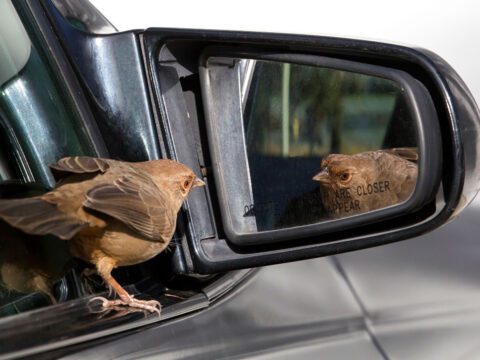Gabon Update: Elephants Enter the Bai
By Liz Rowland October 5, 2010This month we’re taking occasional time-outs to hear about elephant research that Peter Wrege and Liz Rowland, of our Elephant Listening Project, are conducting in Gabon (previous posts here). Peter is a veteran of many trips to Gabon, but this is Liz’s first time seeing forest elephants. Last week, she saw her first four. A few nights later, she witnessed a full-on elephant party in the clearing. Here’s her account:
26 Sept
Finally, Peter, Eugene (our Gabonese colleague), and I are on the observation platform overlooking the Grand Saline bai (forest clearing), watching for forest elephants. They come here to drink from the mineral-rich springs in the watercourse. We want to know whether elephants use these areas differently in day and night.
To find out, we climb into a tree platform early in the morning and settle down to watch and listen for an entire day and night in silence. Bird and primate calls alternate with fish splashing in the pond and thwacks as one of us swats at a fly. The hours tick by and the day heats up. No elephants. A kingfisher flits over the stream and wagtails strut around on the sandy islands.
Eventually darkness falls, the air cools down, and everything begins to feel even damper. We take it in turns to keep watch, scanning the bai regularly with night-vision binoculars, which transform everything into a surreal monochrome image.
We can’t see much, but we can hear a lot. Here’s the sound of the forest, with a tree hyrax calling into the night:
At 11 PM I hear a beautiful deep, long, elephant rumble from behind the platform, but nothing appears. Finally, at 1 AM three large dark shapes appear from the forest, only about 35 feet from our platform: a mother elephant and her two young. They push their trunks down into the spring and loudly blow out the surface water, then suck up the mineral-rich water into their trunks and carefully pour it into their mouths.
Mum is nervous though and doesn’t settle to drinking. She turns this way and that and puts her trunk up vertically like a snorkel to smell the air (elephants have an extremely sensitive sense of smell). Perhaps she can smell us, or is nervous because elephants have been poached here within the last couple of months.
A few minutes later, the elephants trot off out of the bai, disappearing down one of the many elephant trails that lead into the forest (more about baby elephants, with photos). I’ve now seen forest elephants, and one of my dreams has come true.
29 Sept
We’ve spent another elephantless daytime at the bai. But the night doesn’t disappoint us! At first a group of seven appear, far off to the left, and make their way down into the stream. And then more appear. They keep coming and within about half an hour, there are more elephants then we can cope with! We soon give up on trying to record the sex and age of each.
It’s enough of a challenge just to count them. If only they would stand still for a few moments, but no, they either huddle together in tight groups or wander up and down so we can’t keep track of them. I try different techniques—counting first bums, then trunks, but just when I’ve got the same answer twice one moves to reveal yet another elephant. The consensus is that we have 27 elephants.
Why are there so many tonight? Until now, the maximum we’ve had at once is seven. The moon isn’t especially full, and we’ve not had rain. Have they all coordinated their movements to arrive at the same time, rumbling the news to each other through the forest, or is it just chance? Whatever the reason, this is certainly an opportunity for them to socialize.
While most stay in the stream far to our left, one large male strolls alone into the big pond in front of us. He swishes his trunk lazily in the water and flaps his ears, making loud thwacks, then drinks. He’s evidently in musth (the reproductive state that male elephants come into once a year): he has enlarged glands on his forehead that secrete fluid. Soon, a family group of six enters the pond too. The male doesn’t seem to take much notice at first, but then approaches one of the females, sniffing her to see if she’s in heat. No luck though, and he wanders off, allowing another adult female to dominate the spring there.
After a while, more elephants wander near us. Two young males joust—interlocking their tusks and pushing each other backwards. Meanwhile, some of the other youngsters get into trouble. They lose track of mum and give the “help me” aooga call (a rumble-roar combination), to which mum responds with a reassuring rumble. Some elephants find the ideal rubbing log and back up against it to rub their backsides. I can just imagine the satisfied expression on their faces!
A mother with a tiny infant stays out of the way most of the time, presumably so her youngster doesn’t get trampled. Some elephants have now climbed up out of the stream and are milling around near our platform. Elephants are everywhere! It’s really quite noisy what with the bubbling and blowing, calling and ear flapping, and the occasional fart! After a couple of hours, they start to wander off and within half an hour they’re all gone. We each turn on our headlamps and frantically scribble in our notebooks, trying to recall events. That was perhaps a few too many elephants at once. Be careful what you ask for!
Read more about the trip:


All About Birds is a free resource
Available for everyone,
funded by donors like you






